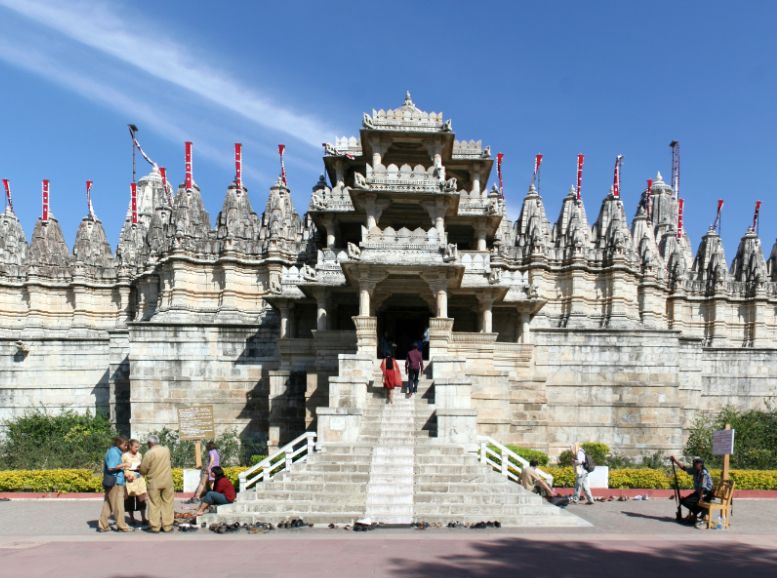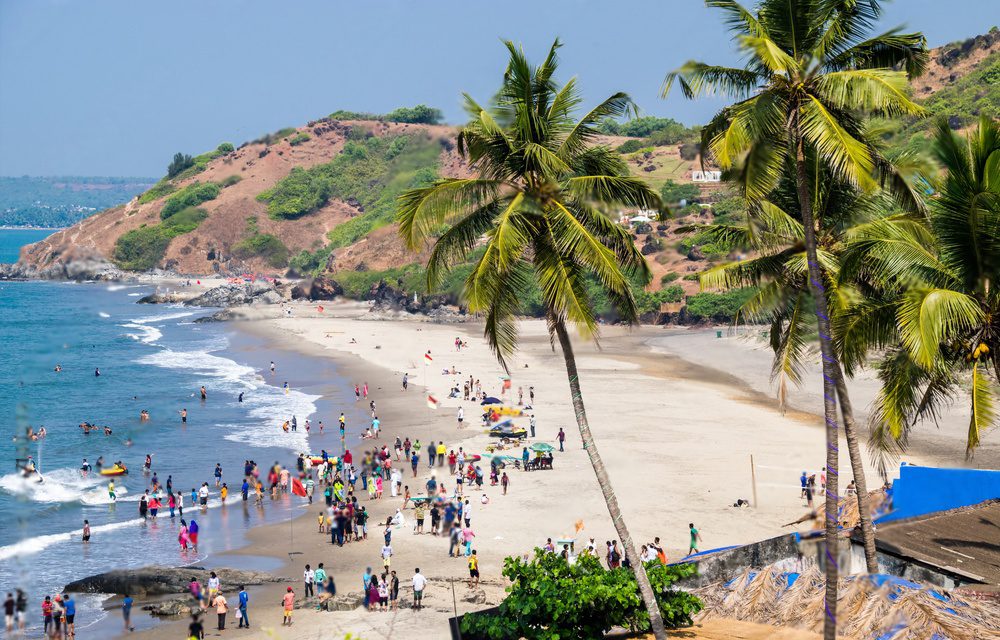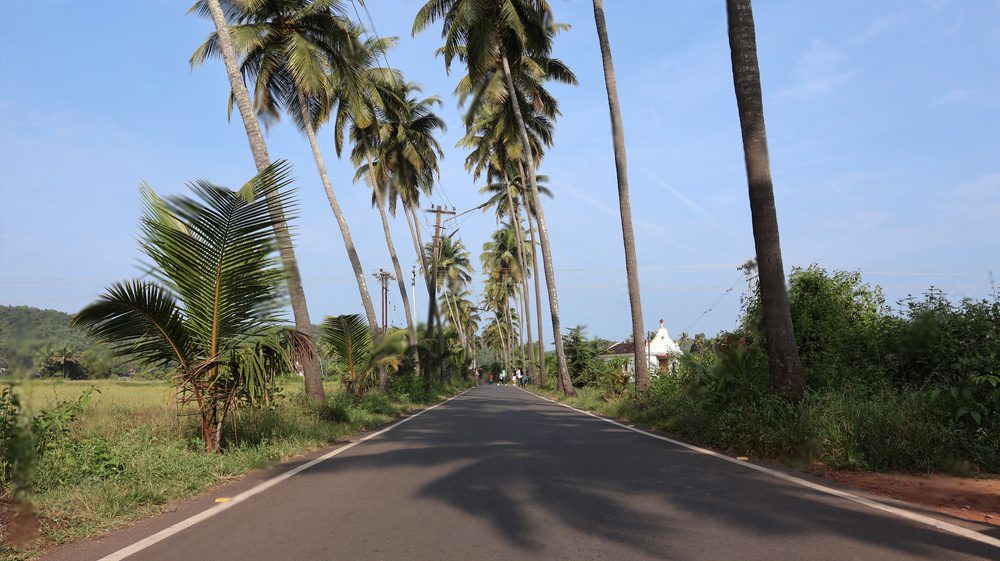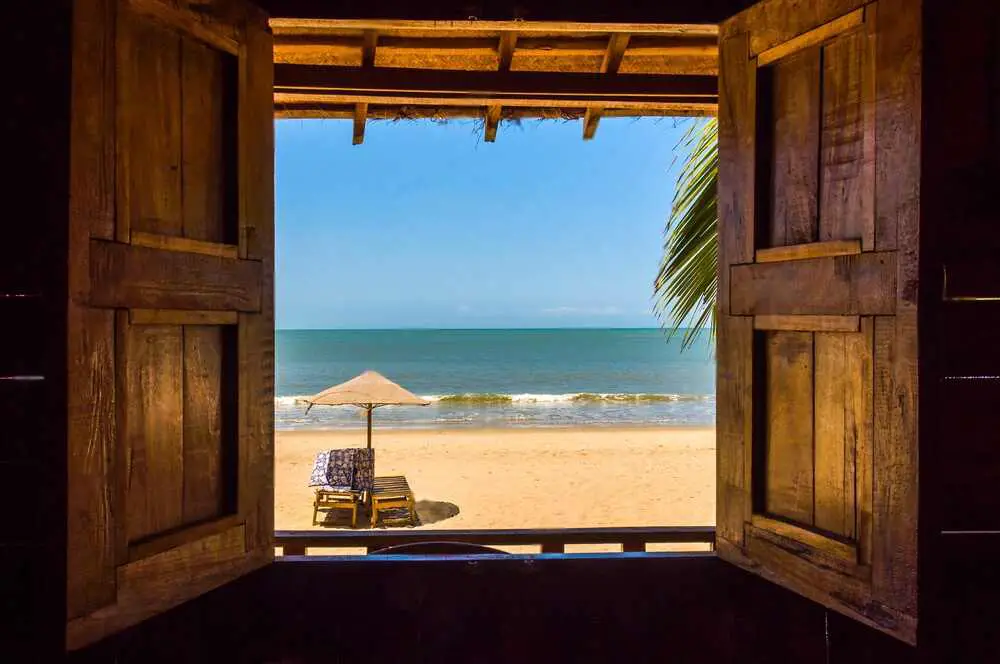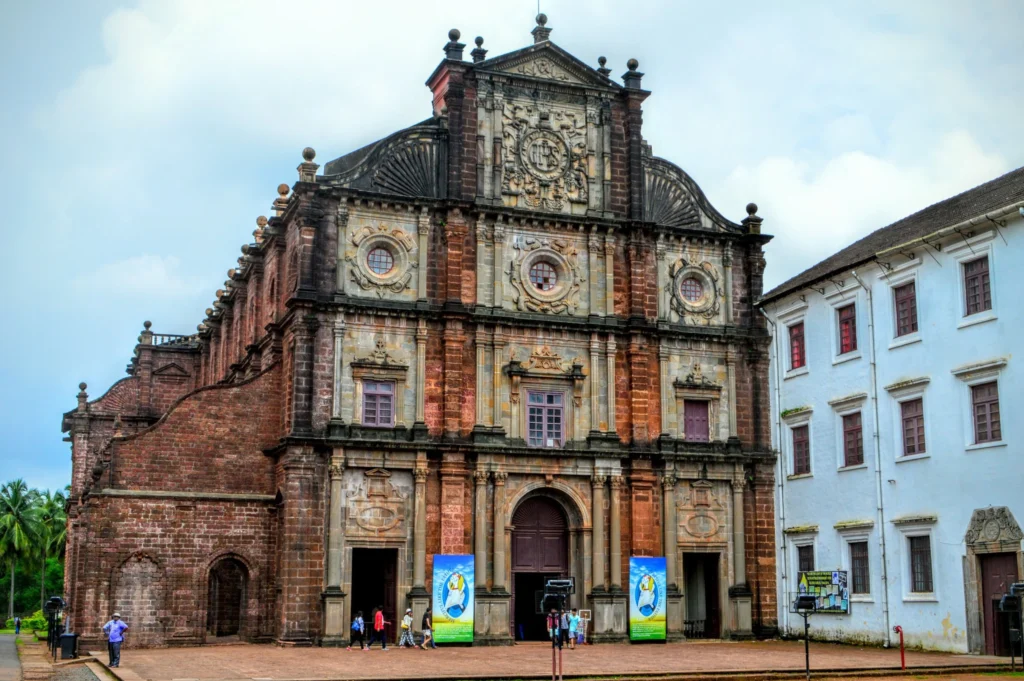In the verdant embrace of Rajasthan’s Aravalli Range lies a jewel of timeless beauty – the Ranakpur Jain Temple. Revered as one of the world’s most magnificent Jain temples, Ranakpur is a testament to architectural grandeur and spiritual devotion.
Stepping into Ranakpur’s sacred grounds is like entering a realm of serenity and splendor. Intricate marble architecture unfolds before you, adorned with exquisite carvings and delicate filigree. Each pillar, dome, and corridor whispers a story of devotion, echoing the divine presence that permeates this space.
How to reach:
Air: The closest airport is Maharana Pratap Airport (UDR) in Udaipur, roughly 100 kilometers away. Taxis and buses are readily available at the airport for the 2-3 hour journey to Ranakpur, depending on your chosen mode of transport and road conditions.
Train: While Ranakpur lacks its own train station, Falna Railway Station, about 30 kilometers distant, offers good connections to major cities like Delhi, Mumbai, and Jaipur. Taxis and buses can then whisk you to Ranakpur from Falna.
Road: Ranakpur boasts excellent road connectivity to various cities and towns in Rajasthan and neighboring states. Located on the Udaipur-Jodhpur highway (NH-162), it’s easily accessible by car from nearby destinations. Consider driving from Udaipur (approximately 90 kilometers), Jodhpur (approximately 160 kilometers), or Jaipur (approximately 350 kilometers). Alternatively, state-run buses or private taxis offer convenient options from these cities to Ranakpur.
Best time to visit:
Winter Wonderland (October – March): Pleasant weather with clear skies makes winter the peak season at Ranakpur. Daytime temperatures range from 10°C to 25°C, perfect for sightseeing and outdoor exploration. The comfortable climate allows visitors to delve into the temple complex and its surroundings without enduring the summer’s scorching heat.
Monsoon Marvel (July – September): The monsoon season brings life-giving rain to Ranakpur, transforming the surrounding landscape with lush greenery and fresh air. This creates a serene atmosphere, ideal for nature lovers and photographers seeking picturesque scenes. However, heavy rainfall can disrupt travel plans, so checking weather forecasts and road conditions beforehand is crucial.
Serene Summer (April – June): Summer in Ranakpur can be hot and dry, with daytime temperatures reaching 40°C or higher. While the heat may deter some visitors, early mornings and evenings offer cooler options for temple visits. If you don’t mind the warmth, summer can be a peaceful time to explore Ranakpur with fewer crowds and potentially better accommodation availability.
Post-Monsoon Paradise (October – November): The post-monsoon season brings pleasant weather with landscapes still flourishing from the recent rains. This shoulder season offers a sweet spot between the summer heat and winter chill, making it ideal for those seeking tranquility and moderate temperatures.
Attractions:
Main Temple Complex:
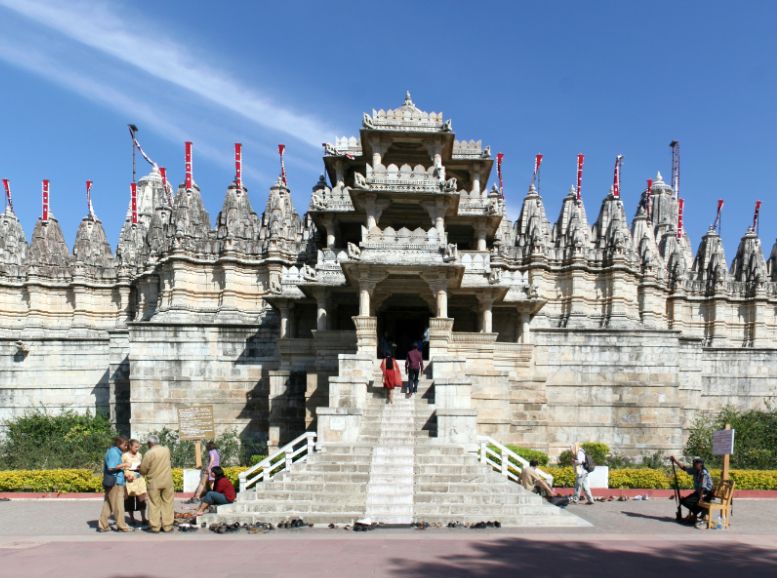

The Ranakpur Jain Temple complex stuns with its architectural brilliance. Intricate marble carvings, majestic domes, and a forest of 1,444 exquisitely crafted marble pillars leave visitors speechless. Dedicated to Lord Adinath, the first Jain Tirthankara, the main temple is adorned with ornate sculptures depicting deities and Jain motifs. Wander through colossal halls, each a testament to the dedication and skill of Jain artisans. As natural light filters through ornate windows, casting a soft glow on the intricate details, prepare to be awestruck by the sheer beauty and spiritual significance of this architectural wonder.
Marble Pillars: Ranakpur Jain Temple
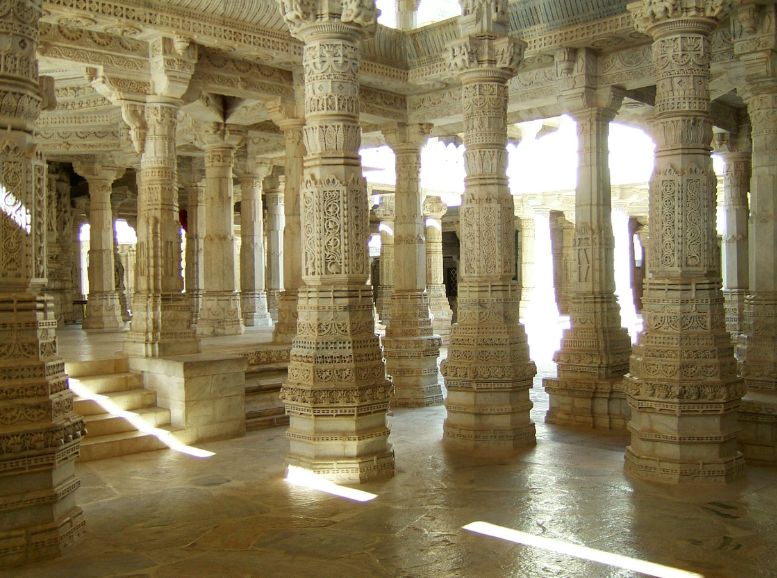

Jain Temple boasts an awe-inspiring display of artistry in its elaborate system of marble pillars. No two pillars are alike – each of the 1,444 is a unique masterpiece. Intricate designs and Jain motifs, some featuring celestial dancers, mythical creatures, and sacred symbols, adorn these pillars. The craftsmanship extends beyond aesthetics – the precise construction creates a natural cooling system within the temple, offering a welcome respite even on the hottest days. Adding to the mystical aura, legend whispers that a celestial musician, son of Neminath, provided the architectural plan for the temple in a dream.
Surya Narayan Temple:
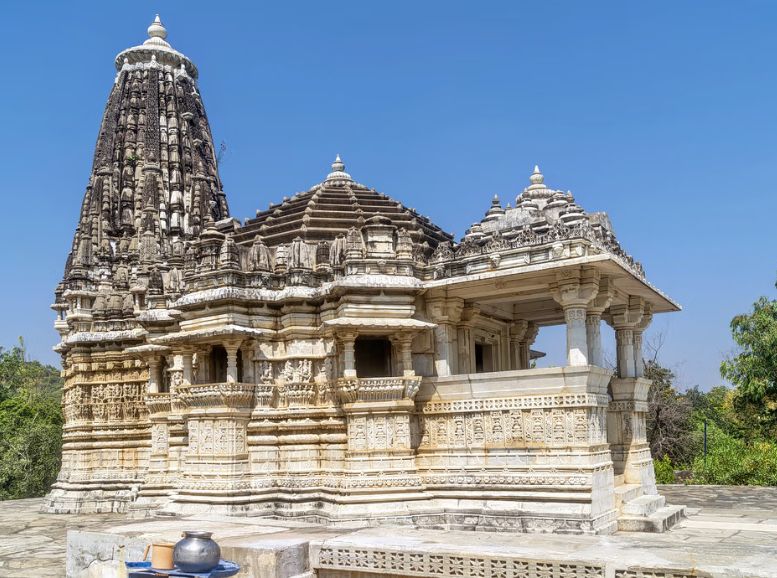

Standing shoulder-to-shoulder with the main temple complex is the Surya Narayan Temple, a radiant tribute to the Sun God. Bathed in the very light it reveres, the temple boasts beautifully carved panels that come alive with a procession of Hindu deities and celestial beings. These intricate artworks aren’t merely decorative; they offer a captivating window into the rich tapestry of religious beliefs that have found a home at Ranakpur.
Local experiences:
Village Echoes: Step beyond the temple and delve into the nearby villages. Leisurely walks introduce you to local culture, traditions, and the rustic charm of village homes. Interact with friendly residents and gain a deeper appreciation for their way of life.
A Culinary Journey: Indulge in the flavors of Rajasthan at local eateries and roadside dhabas. Savor traditional dishes like dal baati churma, gatte ki sabzi, and ker sangri, bursting with fresh ingredients and aromatic spices.
Artisan Encounters: Immerse yourself in age-old traditions through hands-on workshops. Learn pottery, block printing, or weaving from skilled artisans. Create your own souvenirs and gain insights into these time-honored crafts.
Visions of Folklore: Witness Rajasthan’s vibrant culture come alive with captivating folk music and dance performances. Be mesmerized by Ghoomar, Kalbeliya, and Bhavai dances, adorned with colorful costumes and accompanied by soulful music.
Rural Escapes: Embark on a rural safari or jeep tour to explore the scenic countryside. Traverse rugged terrains, discover scenic viewpoints, and encounter local wildlife amidst the tranquility of the rural landscape.
Farm Fresh Experiences: Visit local farms and orchards to learn traditional practices and gain firsthand experience of agricultural life. Participate in activities like milking cows, plowing fields, or harvesting crops.
Culinary Secrets Revealed: Unveil the culinary secrets of Rajasthan through cooking classes with local chefs. Source fresh ingredients from local markets and learn to cook traditional recipes using age-old techniques and spices.
Travel tips:
- Timing: Check the temple’s opening hours and any specific entry requirements before your visit. To avoid crowds, consider weekdays or early mornings, especially during peak season.
- Dress Code: Respect the temple’s sanctity. Dress modestly with shoulders and knees covered. It’s customary to remove shoes before entering.
- Respect the Art: Refrain from touching or leaning on the delicate marble carvings and pillars. Maintain a quiet demeanor and avoid disruptive behavior.
- Photography Guidelines: While generally allowed, photography might be restricted in certain areas or during ceremonies. Respect signage and instructions regarding photography and videography.
- Sun Protection: Pack sunscreen, a hat, and sunglasses for exploring the temple complex and surroundings.
- Mind Your Step: The marble floors can be slippery, especially barefoot. Exercise caution to avoid slips or falls, especially near water or oil lamps.
- Respectful Interactions: Be mindful of local customs and traditions when interacting with priests and locals. Seek permission before taking photographs of people, and respect their privacy and religious practices.
Conclusion
The Ranakpur Jain Temple transcends mere architecture; it’s a spiritual odyssey that resonates within the soul. Intricate marble carvings, majestic pillars, and a serene atmosphere inspire reverence and awe, inviting you into the rich tapestry of Jain heritage and spirituality. As you wander hallowed halls, tracing intricate patterns, you’ll be transported to a timeless realm of devotion. Each element, from pillars to sculptures, resonates with echoes of ancient prayers and rituals, offering a glimpse into Jainism’s profound wisdom. But Ranakpur Jain Temple’s significance extends beyond architectural grandeur. It’s a sanctuary for the soul, welcoming all – pilgrims seeking enlightenment or travelers yearning for beauty – on a journey of self-discovery. Plan your Rajasthan adventure and explore Ranakpur’s hidden gems with Xplro.
FAQs
- What is the significance of the Ranakpur Jain Temple?
- The Ranakpur Jain Temple is a prominent Jain pilgrimage site renowned for its stunning architecture and spiritual significance.
- Who built the Ranakpur Jain Temple?
- The temple was constructed by Seth Dharna Shah, a Jain businessman, in the 15th century under the patronage of Rana Kumbha, the ruler of Mewar.
- What is the architectural style of the Ranakpur Jain Temple?
- The temple showcases Maru-Gurjara architecture, known for its intricate marble carvings, domes, and ornate pillars.
- How many marble pillars are there in the Ranakpur Jain Temple?
- The temple boasts 1,444 marble pillars, each intricately carved with unique designs and motifs.
- Is the Ranakpur Jain Temple open to visitors of all faiths?
- Yes, people of all faiths are welcome to visit the temple and appreciate its beauty, provided they adhere to the temple’s guidelines.
- Are there any dress code requirements to enter the Ranakpur Jain Temple?
- Visitors are required to dress modestly, covering their shoulders and knees, and remove shoes before entering the sanctum sanctorum.
- What are the Ranakpur Jain Temple‘s opening hours?
- The temple is typically open from sunrise to sunset, allowing visitors ample time to explore its intricacies.
- Are photography and videography allowed inside the Ranakpur Jain Temple?
- Yes, visitors can take photographs and videos inside the temple, but there may be restrictions in certain areas or during religious ceremonies.
- Are guided tours available for visitors?
- Yes, guided tours are available for visitors who wish to learn more about the temple’s history, architecture, and religious significance.
- What are some nearby attractions to visit along with the Ranakpur Jain Temple?
- Nearby attractions include Sadri, Surya Narayan Temple, Muchhal Mahavir Temple, and the Kumbhalgarh Fort.
- Is there an entry fee to visit the Ranakpur Jain Temple?
- Yes, visitors usually need to pay a nominal entry fee to enter the temple complex.
- Can visitors participate in any rituals or ceremonies at the Ranakpur Jain Temple?
- Yes, visitors are welcome to participate in the daily rituals and ceremonies conducted at the temple, respecting the sanctity of the proceedings.
